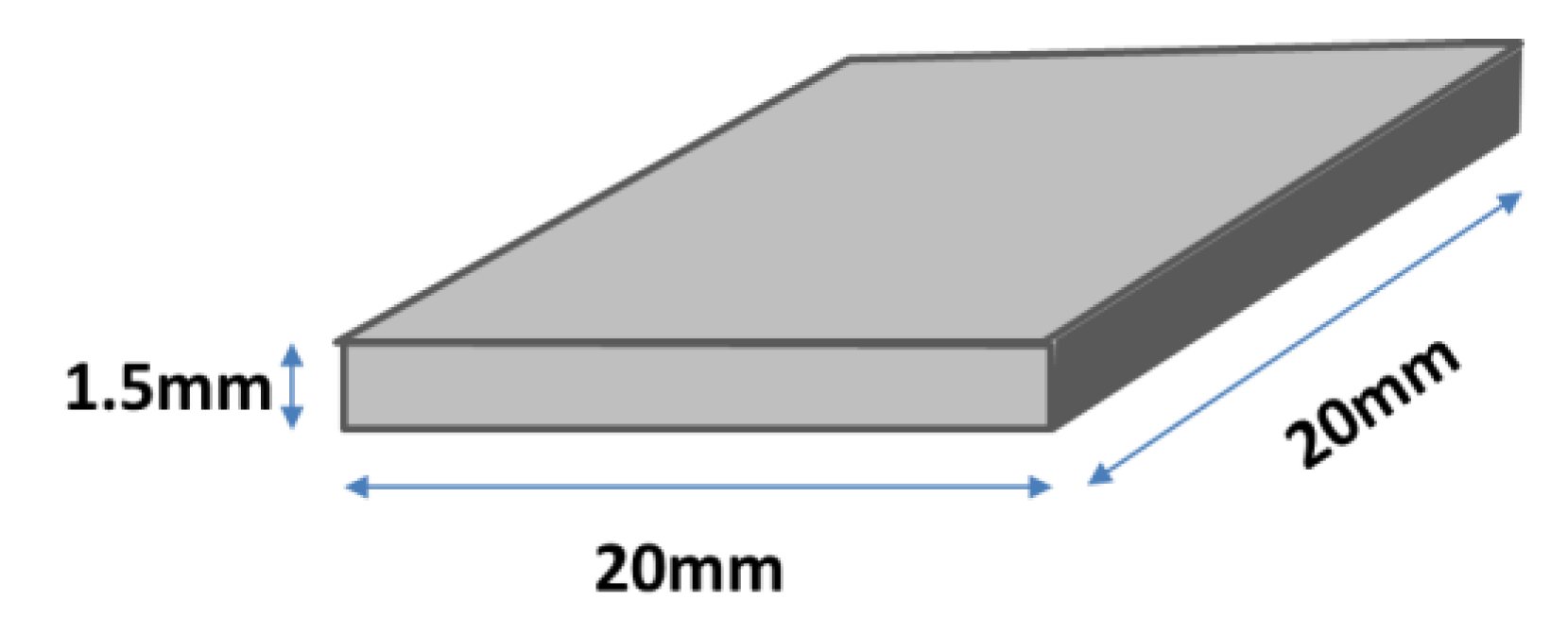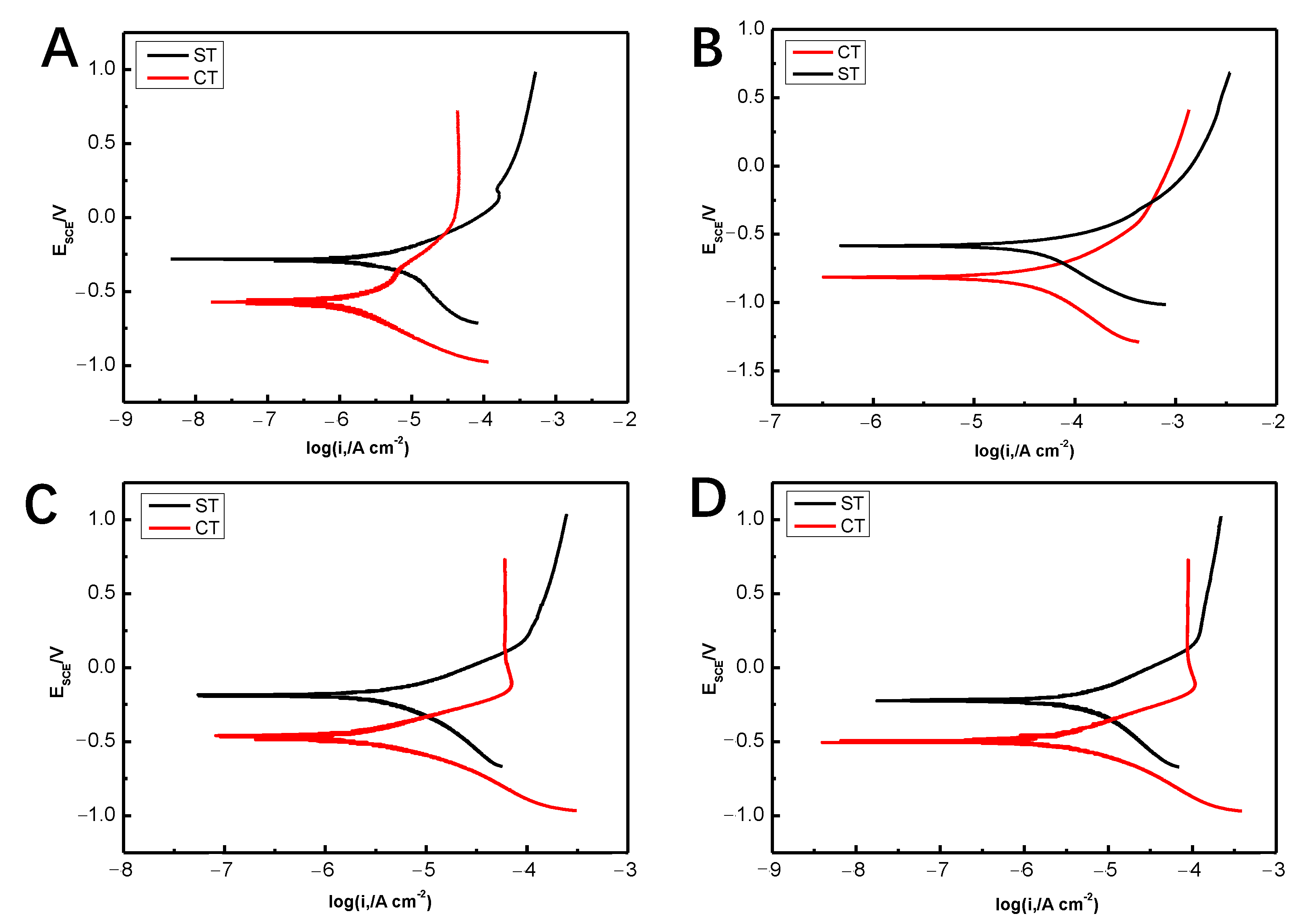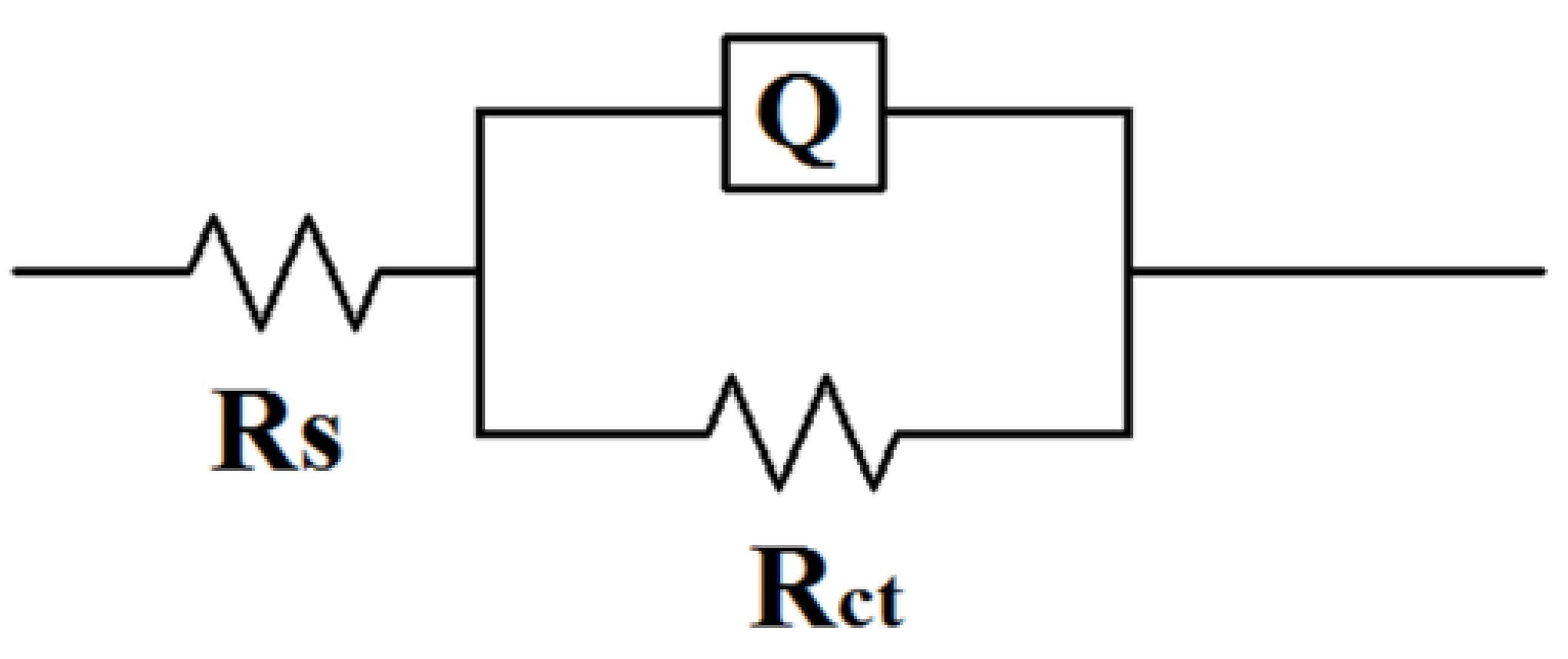Corrosion Performances of Selective Laser Melting Ti6Al4V Alloy in Different Solutions
Abstract
1. Introduction
2. Materials and Methods
2.1. Materials
2.2. Preparation of Samples
2.3. Electrochemical Measurement
2.4. Characterization of Samples
3. Results and Discussion
3.1. Characterization of the Samples
3.2. Electrochemical Studies
4. Conclusions
Author Contributions
Funding
Data Availability Statement
Conflicts of Interest
References
- Sibum, H.; Güther, V.; Roidl, O.; Habashi, F.; Uwe Wolf, H.; Siemers, C. Titanium, Titanium Alloys, and Titanium Compounds. In Ullmann’s Encyclopedia of Industrial Chemistry; Bohnet, M., Ed.; Wiley-VCH Publishing: Weinheim, Germany, 2003; pp. 1–35. [Google Scholar]
- Ory, F.; Fraysse, J.L. 1.4—Titanium and titanium alloys: Materials, review of processes for orthopedics and a focus on a proprietary approach to producing cannulated bars for screws and nails for trauma. In Titanium in Medical and Dental Applications; Froes, F.H., Qian, M., Eds.; Woodhead Publishing: Sawston, UK, 2018; pp. 65–91. [Google Scholar]
- Kityk, A.; Protsenko, V.; Danilov, F.; Bobrova, L.; Hnatko, M.; Pavlik, V.; Šoltýs, J.; Labudová, M.; Rusková, M.; Pangallo, D. Design of Ti-6Al-4V alloy surface properties by galvanostatic electrochemical treatment in a deep eutectic solvent Ethaline. Surf. Coat. Technol. 2022, 429, 127936. [Google Scholar] [CrossRef]
- Liu, S.; Shin, Y.C. Additive manufacturing of Ti6Al4V alloy: A review. Mater. Des. 2019, 164, 107552. [Google Scholar] [CrossRef]
- Fu, Q.; Hong, Y.; Liu, X.; Fan, H.; Zhang, X. A hierarchically graded bioactive scaffold bonded to titanium substrates for attachment to bone. Biomaterials 2011, 32, 7333–7346. [Google Scholar] [CrossRef]
- Chen, Y.; Frith, J.E.; Dehghan-Manshadi, A.; Attar, H.; Kent, D.; Soro, N.D.M.; Bermingham, M.J.; Dargusch, M.S. Mechanical properties and biocompatibility of porous titanium scaffolds for bone tissue engineering. J. Mech. Behav. Biomed. Mater. 2017, 75, 169–174. [Google Scholar] [CrossRef] [PubMed]
- Tang, H.P.; Wang, J.; Qian, M. 28—Porous titanium structures and applications. In Titanium Powder Metallurgy; Qian, M., Froes, F.H., Eds.; Butterworth-Heinemann: Boston, MA, USA, 2015; pp. 533–554. [Google Scholar]
- Reig, L.; Amigó, V.; Busquets, D.J.; Calero, J.A. Development of porous Ti6Al4V samples by microsphere sintering. J. Mater. Process. Technol. 2012, 212, 3–7. [Google Scholar] [CrossRef]
- He, G.; Liu, P.; Tan, Q. Porous titanium materials with entangled wire structure for load-bearing biomedical applications. J. Mech. Behav. Biomed. Mater. 2012, 5, 16–31. [Google Scholar] [CrossRef] [PubMed]
- Jia, J.; Siddiq, A.R.; Kennedy, A.R. Porous titanium manufactured by a novel powder tapping method using spherical salt bead space holders: Characterisation and mechanical properties. J. Mech. Behav. Biomed. Mater. 2015, 48, 229–240. [Google Scholar] [CrossRef]
- Tofail, S.A.M.; Koumoulos, E.P.; Bandyopadhyay, A.; Bose, S.; O’Donoghue, L.; Charitidis, C. Additive manufacturing: Scientific and technological challenges, market uptake and opportunities. Mater. Today 2018, 21, 22–37. [Google Scholar] [CrossRef]
- Leary, M. Chapter 1—Introduction to AM. In Design for Additive Manufacturing; Leary, M., Ed.; Elsevier Publishing: AE Amsterdam, The Netherlands, 2020; pp. 1–6. [Google Scholar]
- Ngo, T.D.; Kashani, A.; Imbalzano, G.; Nguyen, K.T.Q.; Hui, D. Additive manufacturing (3D printing): A review of materials, methods, applications and challenges. Compos. Part B Eng. 2018, 143, 172–196. [Google Scholar] [CrossRef]
- Yadroitsev, I.; Smurov, I. Selective laser melting technology: From the single laser melted track stability to 3D parts of complex shape. Phys. Procedia 2010, 5, 551–560. [Google Scholar] [CrossRef]
- Fan, Z.; Lu, M.; Huang, H. Selective laser melting of alumina: A single track study. Ceram. Int. 2018, 44, 9484–9493. [Google Scholar] [CrossRef]
- Sing, S.L.; Wiria, F.E.; Yeong, W.Y. Selective laser melting of lattice structures: A statistical approach to manufacturability and mechanical behavior. Robot. Comput.-Integr. Manuf. 2018, 49, 170–180. [Google Scholar] [CrossRef]
- Chiu, T.-M.; Mahmoudi, M.; Dai, W.; Elwany, A.; Liang, H.; Castaneda, H. Corrosion assessment of Ti-6Al-4V fabricated using laser powder-bed fusion additive manufacturing. Electrochim. Acta 2018, 279, 143–151. [Google Scholar] [CrossRef]
- Masoomi, M.; Thompson, S.M.; Shamsaei, N. Laser powder bed fusion of Ti-6Al-4V parts: Thermal modeling and mechanical implications. Int. J. Mach. Tools Manuf. 2017, 118, 73–90. [Google Scholar] [CrossRef]
- Dai, N.; Zhang, L.-C.; Zhang, J.; Chen, Q.; Wu, M. Corrosion behavior of selective laser melted Ti-6Al-4V alloy in NaCl solution. Corros. Sci. 2016, 102, 484–489. [Google Scholar] [CrossRef]
- Nicoletto, G. Anisotropic high cycle fatigue behavior of Ti–6Al–4V obtained by powder bed laser fusion. Int. J. Fatigue 2017, 94, 255–262. [Google Scholar] [CrossRef]
- Cui, Y.-W.; Chen, L.-Y.; Qin, P.; Li, R.; Zang, Q.; Peng, J.; Zhang, L.; Lu, S.; Wang, L.; Zhang, L.-C. Metastable pitting corrosion behavior of laser powder bed fusion produced Ti-6Al-4V in Hank’s solution. Corros. Sci. 2022, 203, 110333. [Google Scholar] [CrossRef]
- Macallister, N.; Vanmeensel, K.; Becker, T.H. Fatigue crack growth parameters of Laser Powder Bed Fusion produced Ti-6Al-4V. Int. J. Fatigue 2021, 145, 106100. [Google Scholar] [CrossRef]
- Ter Haar, G.M.; Becker, T.H. Laser powder bed fusion produced Ti-6Al-4V: Influence of high-energy process parameters on in-situ martensite decomposition and prior beta grain texture. J. Alloys Compd. 2022, 918, 165497. [Google Scholar] [CrossRef]
- Chen, Z.; Wu, X.; Davies, C.H.J. Process variation in Laser Powder Bed Fusion of Ti-6Al-4V. Addit. Manuf. 2021, 41, 101987. [Google Scholar] [CrossRef]
- Brown, D.W.; Anghel, V.; Balogh, L.; Clausen, B.; Johnson, N.S.; Martinez, R.M.; Pagan, D.C.; Rafailov, G.; Ravkov, L.; Strantza, M.; et al. Evolution of the Microstructure of Laser Powder Bed Fusion Ti-6Al-4V During Post-Build Heat Treatment. Metall. Mater. Trans. A 2021, 52, 5165–5181. [Google Scholar] [CrossRef]
- Ataee, A.; Li, Y.; Brandt, M.; Wen, C. Ultrahigh-strength titanium gyroid scaffolds manufactured by selective laser melting (SLM) for bone implant applications. Acta Mater. 2018, 158, 354–368. [Google Scholar] [CrossRef]
- Vrancken, B.; Thijs, L.; Kruth, J.P.; Van Humbeeck, J. Microstructure and mechanical properties of a novel β titanium metallic composite by selective laser melting. Acta Mater. 2014, 68, 150–158. [Google Scholar] [CrossRef]
- Oyane, A.; Kim, H.-M.; Furuya, T.; Kokubo, T.; Miyazaki, T.; Nakamura, T. Preparation and assessment of revised simulated body fluids. J. Biomed. Mater. Res. Part A 2003, 65A, 188–195. [Google Scholar] [CrossRef]
- Bai, Y.; Gai, X.; Li, S.; Zhang, L.-C.; Liu, Y.; Hao, Y.; Zhang, X.; Yang, R.; Gao, Y. Improved corrosion behaviour of electron beam melted Ti-6Al–4V alloy in phosphate buffered saline. Corros. Sci. 2017, 123, 289–296. [Google Scholar] [CrossRef]
- Zhao, X.L.; Li, S.J.; Zhang, M.; Liu, Y.D.; Sercombe, T.B.; Wang, S.G.; Hao, Y.L.; Yang, R.; Murr, L.E. Comparison of the microstructures and mechanical properties of Ti–6Al–4V fabricated by selective laser melting and electron beam melting. Mater. Des. 2016, 95, 21–31. [Google Scholar] [CrossRef]
- Safdar, A.; Wei, L.Y.; Snis, A.; Lai, Z. Evaluation of microstructural development in electron beam melted Ti-6Al-4V. Mater. Charact. 2012, 65, 8–15. [Google Scholar] [CrossRef]
- Yadroitsev, I.; Krakhmalev, P.; Yadroitsava, I. Selective laser melting of Ti6Al4V alloy for biomedical applications: Temperature monitoring and microstructural evolution. J. Alloy. Compd. 2014, 583, 404–409. [Google Scholar] [CrossRef]
- Dai, N.; Zhang, L.-C.; Zhang, J.; Zhang, X.; Ni, Q.; Chen, Y.; Wu, M.; Yang, C. Distinction in corrosion resistance of selective laser melted Ti-6Al-4V alloy on different planes. Corros. Sci. 2016, 111, 703–710. [Google Scholar] [CrossRef]
- Gudić, S.; Vrsalović, L.; Kvrgić, D.; Nagode, A. Electrochemical Behaviour of Ti and Ti-6Al-4V Alloy in Phosphate Buffered Saline Solution. Materials 2021, 14, 7495. [Google Scholar] [CrossRef]





| C | H | O | N | Fe | Al | V | Ti | |
|---|---|---|---|---|---|---|---|---|
| ST | 0.01 | 0.015 | 0.19 | 0.021 | 0.23 | 6.15 | 4.03 | Bal. |
| CT | 0.02 | 0.001 | 0.11 | 0.016 | 0.53 | 6.18 | 4.04 | Bal. |
| Sample | Solution | Ecorr/V | jcorr/μA cm−2 | βa/V | βc/V | Ep/V | ip/μA cm−2 |
|---|---|---|---|---|---|---|---|
| ST | 3.5wt.% NaCl solution | −0.292 | 2.511 ± 0.036 | 114.8 | −109.5 | 0.279 | 136 |
| 15wt.% NaCl solution | −0.563 | 7.065 ± 0.041 | 179.3 | −156.2 | - | - | |
| PBS buffer solution | −0.189 | 1.780 ± 0.025 | 115.6 | −154.3 | 0.233 | 105 | |
| SBF solution | −0.225 | 2.433 ± 0.029 | 164.4 | −189.2 | 0.247 | 124 | |
| CT | 3.5wt.% NaCl solution | −0.547 | 1.493 ± 0.031 | 146.7 | −154.6 | 0.020 | 41.6 |
| 15wt.% NaCl solution | −0.708 | 5.972 ± 0.027 | 98.97 | −138.4 | - | - | |
| PBS buffer solution | −0.470 | 1.019 ± 0.033 | 131.0 | −113.5 | −0.0836 | 69.8 | |
| SBF solution | −0.497 | 1.085 ± 0.037 | 122.8 | −94.41 | 0.0503 | 89.9 |
| Sample | Solution | Rs/(Ω cm−2) | Y0×10−4/(S Secn cm−2) | n | Rct/(kΩ cm−2) |
|---|---|---|---|---|---|
| ST | 3.5wt.% NaCl solution | 7.86 ± 1.76 | 1.06 | 0.87 | 25.2 ± 0.4 |
| 15wt.% NaCl solution | 16.8 ± 1.93 | 1.85 | 0.83 | 17.9 ± 0.2 | |
| PBS buffer solution | 28.4 ± 2.58 | 0.80 | 0.88 | 39.8 ± 0.1 | |
| SBF solution | 22.6 ± 2.40 | 0.78 | 0.89 | 28.1 ± 0.2 | |
| CT | 3.5wt.% NaCl solution | 8.61 ± 3.11 | 0.93 | 0.93 | 36.8 ± 0.3 |
| 15wt.% NaCl solution | 13.4 ± 2.79 | 1.93 | 0.85 | 21.3 ± 0.1 | |
| PBS buffer solution | 27.9 ± 2.82 | 0.97 | 0.93 | 84.0 ± 0.1 | |
| SBF solution | 24.3 ± 1.65 | 1.16 | 0.93 | 63.4 ± 0.2 |
Disclaimer/Publisher’s Note: The statements, opinions and data contained in all publications are solely those of the individual author(s) and contributor(s) and not of MDPI and/or the editor(s). MDPI and/or the editor(s) disclaim responsibility for any injury to people or property resulting from any ideas, methods, instructions or products referred to in the content. |
© 2023 by the authors. Licensee MDPI, Basel, Switzerland. This article is an open access article distributed under the terms and conditions of the Creative Commons Attribution (CC BY) license (https://creativecommons.org/licenses/by/4.0/).
Share and Cite
Chen, X.; Liao, Q.; Gong, M.; Fu, Q. Corrosion Performances of Selective Laser Melting Ti6Al4V Alloy in Different Solutions. Metals 2023, 13, 192. https://doi.org/10.3390/met13020192
Chen X, Liao Q, Gong M, Fu Q. Corrosion Performances of Selective Laser Melting Ti6Al4V Alloy in Different Solutions. Metals. 2023; 13(2):192. https://doi.org/10.3390/met13020192
Chicago/Turabian StyleChen, Xuedan, Qilong Liao, Min Gong, and Qingshan Fu. 2023. "Corrosion Performances of Selective Laser Melting Ti6Al4V Alloy in Different Solutions" Metals 13, no. 2: 192. https://doi.org/10.3390/met13020192
APA StyleChen, X., Liao, Q., Gong, M., & Fu, Q. (2023). Corrosion Performances of Selective Laser Melting Ti6Al4V Alloy in Different Solutions. Metals, 13(2), 192. https://doi.org/10.3390/met13020192





